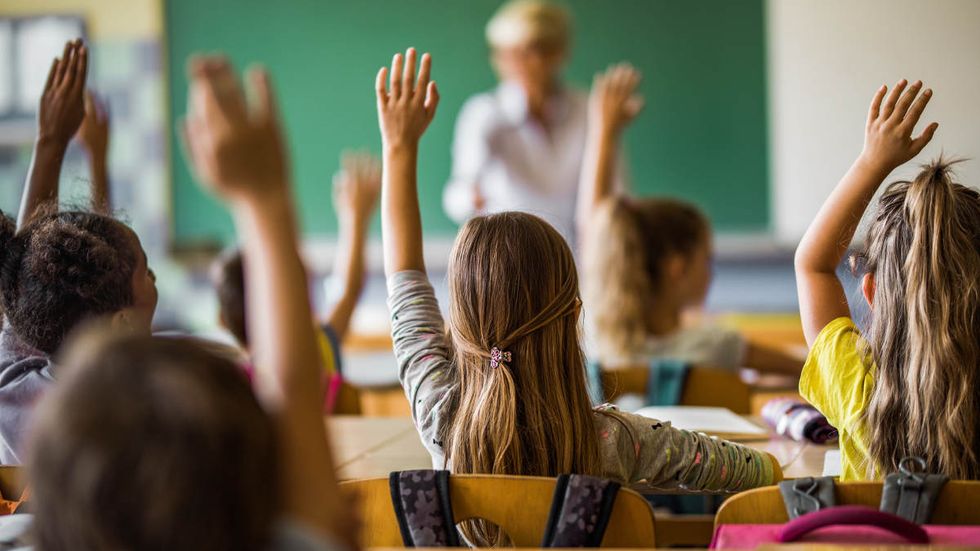
© 2024 Blaze Media LLC. All rights reserved.
Even those promoting lockdown policies will readily admit that this virus will not go away until we achieve herd immunity in some form. What if I told you there is a risk-free way to get the youngest people to achieve herd immunity, shield the vulnerable populations, and avoid the incalculable cost of lost education and mental health for an entire generation of schoolchildren – not to mention freeing up their parents to work?
Closing schools was the biggest mistake of this lockdown, with the possible exception of banning non-emergency surgeries. They should have been the last thing to close, not the first thing. In fact, given that there is, statistically speaking, close to a 0% death rate among school-age children from the coronavirus, schools should never have been shut. They are certainly more essential than lawn and gardening or dog grooming and are perfectly capable of following the same guidelines. Now that the data and research are in, based on samples of millions of cases, it’s time to rectify that mistake first, not last.
Settled fact: The COVID-19 death rate among children is astronomically low
According to the CDC, three children aged 5-14 died of COVID-19 in the entire country. Another 42 died among those aged 15-24. Those are simply astounding numbers, given that numerous serology studies indicate that tens of millions of people have likely gotten the virus already. Moreover, once those numbers are so statistically insignificant, one would have to dig in to further research to see if those children had serious underlying conditions and/or perhaps died with COVID-19, not because of COVID-19, since we know how deaths are being counted.
If that is enough to shut schools and invite so much mental health, educational, social, and family upheaval, then we may die as a nation. According to the CDC, approximately 12,000 children die from unintentional injuries every year.
While an infinitesimal number of children did become sick enough to warrant hospitalization, according to the CDC, “For children (0-17 years), COVID-19 hospitalization rates are much lower than influenza hospitalization rates during recent influenza seasons.”
Further research is required to determine whether kids with pre-existing conditions (beyond immunodeficiencies) are at risk like adults and which conditions are at risk, but it’s settled science that healthy school-age kids are not at risk.
Obviously, the faculty is older, and clearly the schools would have to find replacements for those who are seniors or have health conditions, but that is no different from the policies we would recommend for any essential business that is open. It would be ludicrous to shut down the education and social environment of a generation of children indefinitely for those personnel shortfalls. That’s also why it’s incomprehensible for governments to leave open super-spreader subways for everyone, but ban children’s playdates.
But what about children spreading to a vulnerable population?
Inevitably, proponents of indefinite lockdown will charge, “Even if children have no risk of killing each other, they will spread it to their grandparents or vulnerable populations while they are asymptomatic and get them killed.”
Even if the premise of mass asymptomatic spread from kids to the elderly is rooted in science, it would not justify a full shutdown. One can easily still abide by guidelines not to have kids around vulnerable populations and for the kids from households with chronically ill people to stay home and get livestreams of their classes. Most young adults who are the parents of school-age children also have a remarkably low fatality rate, which has been proven from multiple data sets, even if it’s not quite as low as for children. And again, for those with parents or siblings with high risks, they would obviously be advised to stay at home, as would any healthy child who shows any signs of temporary respiratory illness or fever.
Take Florida, for example, the third largest state in the country. There has not been a single death in the age bracket under 24 and only 87 deaths for those under 55. How many of those had serious underlying conditions? This is in a state of over 21 million people. In Texas, a state of nearly 30 million people, there have been just 69 deaths among those under 60. In many of the smaller states, there are zero deaths of younger adults of any health status.
Even in New Jersey, the second-hardest-hit state, no school-age children died, while 360 under the age of 50 died, as of May 1. NYC is the only place in the country with statistically significant numbers of younger people (but not kids) who died, but broken down by those with health conditions, only 85 people under the age of 65 (most of them near the upper bound of the age bracket) died without underlying conditions. That is one-half of one percent of all New York City deaths.
Dealing with schoolchildren and their parents is a very manageable problem relative to the problem of the lockdown and can certainly be tailored state by state and county by county.
Evidence shows kids do not transmit COVID-19 to adults in significant numbers
Let’s take this a step further. Is there even a problem with kids being around grandpa? There are now several studies that show the entire premise of mass child-to-adult spread is completely unfounded, and there is certainly no definitive evidence showing that mass child-to-adult spread is a problem.
Switzerland opened its schools after failing to find a single case of child-to-adult transmission, instead positing that adults are the ones who transmit to children. The country has even advised that children under 10 can safely hug their grandparents. “Children are very rarely infected and do not pass on the virus,” said Dr. Daniel Koch, the head of the infectious diseases unit at the Federal Office of Public Health in Bern, last week. “That is why small children pose no risk to high-risk patients or grandparents."
A U.K. study from the Royal College of Pediatrics found that at the very least, children "do not play a significant role" in spreading the virus: A 9-year-old British boy who contracted the virus in the French Alps failed to pass on the virus to a single one of the 170 people he was in contact with.
Iceland, which has done the most extensive testing per capita of any country and has, thus far, achieved very successful results, also found very little risk in child transmission. "We have not found a single instance of a child infecting parents,” said Kari Stefansson of the Icelandic company deCODE genetics.
Preliminary results from a smaller Dutch study found that “children play a small role in the spread of the novel coronavirus. The virus is mainly spread between adults and from adult family members to children.”
Australia is one of the only Western countries that left most schools open for most of the epidemic, and it also found that kids, contrary to popular theory, were not super-spreaders. Australia's National Centre for Immunisation Research and Surveillance (NCIRS) traced 900 contacts among kids who tested positive in schools and found that only two passed on the virus. It’s unclear whether those two receivers were other kids or adults.
At this point, the onus is upon our governments to demonstrate why closing schools and all its collateral damage is justified. If anything, having children spread it to each other is the lowest-risk path to generating more herd immunity, especially given that there is no evidence of any significant child-to-adult spread. And again, it’s understandable if we might want to be more cautious than the Swiss and still keep kids away from seniors, but that should not stop schools from reopening and children from playing with each other.
Taiwan never closed its schools and did not achieve worse results than the other Asian countries with similar demographics that did; it actually had the fewest deaths of all. Singapore closed its schools much later than Hong Kong, and it did not affect Singapore’s outcome, an observation noted by the CDC in a memo last month.
Certainly, weeks after the peak of the virus, it is indefensible for us not to reopen schools. Political amnesia works wonders in America, but have we all forgotten that New York City Mayor Bill de Blasio, of all people, actually vigorously opposed the effort to shut local schools in March and believed it was totally unnecessary?
How a densely populated Israeli town full of children proves the folly of closing schools
For those doubting the accuracy of the numerous European studies demonstrating little or no child-to-adult SARS-CoV-2 transmission, the Israeli town of Bnei Brak serves as a real-life example. This is a town of 200,000, but it is as densely populated as Manhattan because it is composed almost exclusively of very religious Jews who each have extremely large families and live in close quarters. As Israeli researcher Yinon Weiss noted in his riveting article titled, “The Coronavirus Passover Miracle,” Israeli government officials warned that this town was a ticking time bomb of death because they were not following state guidelines on mitigation efforts.
So great was the fear of this town destroying all of Israel that the military was sent out to blockade the town before Passover so nobody could go into or out of the town. So what happened after Passover as the government prepared to survey the damage and dig mass graves for the numberless dead bodies? According to Weiss, 99.99% survived, and only a handful of people died. The town is now fully opened.
What happened?
According to Weiss, the median age of the town is an astoundingly low 17.5 years, less than half the median in the U.S. and much less than the rest of the young country of Israel. They likely passed the disease around very rapidly from child to child and achieved herd immunity with the lowest-risk population of the country – with the ultimate added benefit of more quickly shielding the vulnerable in the long run. The Jerusalem Post quoted local Israeli doctor Elon Ganor as predicting that 50%-60% of the population is likely immune.
Obviously, in most other cities and countries, the share of children isn’t large enough to shield the vulnerable by simply passing it among themselves without any mitigation efforts whatsoever as they did there. But the salient lesson that there is no meaningful risk for school-age children, especially if you keep them away from vulnerable populations, is absolutely a universal, established epidemiological point.
What is quite clear based on any legitimate scientific analysis and data is that there is a much greater case to open schools long before even opening businesses. Yet even the most hawkish governors on opening businesses are squeamish about opening schools because they are terrified of the politics, demagoguery, and media shaming. Which is just another indication why none of these impetuous, erratic, and hypocritical decisions are being driven by science, math, prudence, or regard for public health, but by politics and media virtue-signaling.
Want to leave a tip?
We answer to you. Help keep our content free of advertisers and big tech censorship by leaving a tip today.
Want to join the conversation?
Already a subscriber?
Blaze Podcast Host
Daniel Horowitz is the host of “Conservative Review with Daniel Horowitz” and a senior editor for Blaze News.
RMConservative
more stories
Sign up for the Blaze newsletter
By signing up, you agree to our Privacy Policy and Terms of Use, and agree to receive content that may sometimes include advertisements. You may opt out at any time.
© 2024 Blaze Media LLC. All rights reserved.
Get the stories that matter most delivered directly to your inbox.
By signing up, you agree to our Privacy Policy and Terms of Use, and agree to receive content that may sometimes include advertisements. You may opt out at any time.



